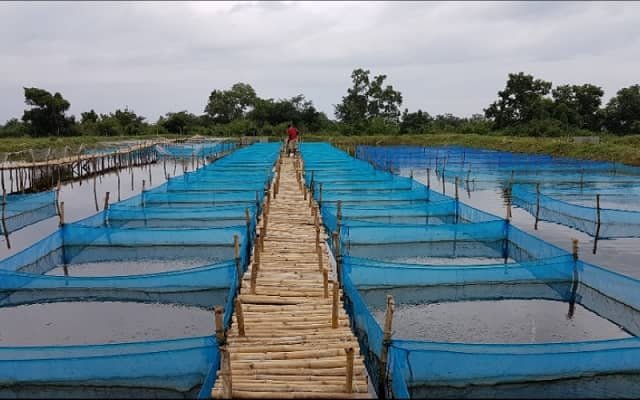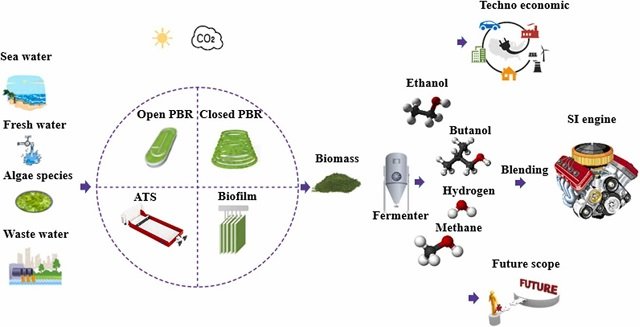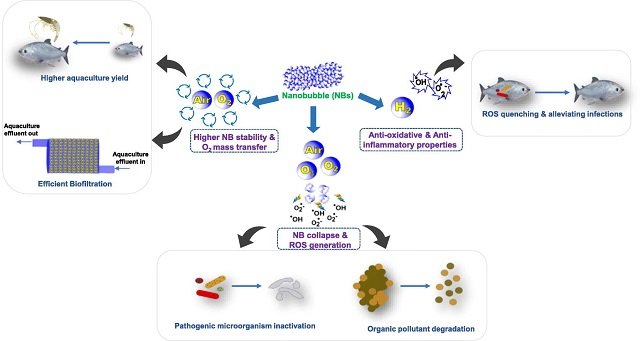
Microalgae cultivation using wastewater is presented as a promising strategy that could revolutionize sustainability in aquaculture and other sectors. This synergy, which combines effluent treatment with the generation of nutrient-rich biomass, aligns perfectly with the concept of a circular bioeconomy. However, a recent review study published in the journal Processes delves into how realistic this approach is today, analyzing its costs, environmental impact, and true technological maturity.
The idea is not new, but scientific interest has skyrocketed. Research results published by scientists from the Bioprocess Intensification Group at the Federal University of Santa Maria show that the combined use of the terms “microalgae” and “wastewater” in scientific databases has generated more than 12,800 research articles between 2010 and 2024, with 62% of them published in the last five years alone. Despite this enthusiasm, large-scale commercial application remains a promise. This analysis seeks to answer a key question: Are we overestimating the potential of this technology or underestimating the obstacles holding back its consolidation?
The potential of phycoremediation: more than just cleaning water
Phycoremediation, the use of microalgae to treat effluents, not only cleans the water but transforms it. Certain microalgae strains, such as Chlorella, Arthrospira, and Scenedesmus, are capable of removing up to 90% of nitrogen and phosphorus from wastewater. At the same time, they produce a biomass rich in proteins, lipids, and carbohydrates, ideal for various applications, including aquaculture feed.
Microalgae have a remarkable metabolic capacity to capture a wide range of contaminants, from heavy metals and pesticides to pharmaceuticals and antibiotics. This is achieved through mechanisms such as bioadsorption (adhesion to the cell surface) and bioabsorption (uptake into the cell).
However, for this process to be efficient, wastewater pretreatments are often required, such as sieving to remove solids or disinfection to reduce microbial competitors, although the ideal goal of the circular economy is to minimize these steps to reduce costs.
Techno-economic analysis: the numbers behind the promise
The main appeal of using wastewater is the reduction of operational costs by eliminating the need for fresh water and synthetic fertilizers. Nevertheless, economic viability critically depends on one factor: biomass productivity.
The study presents two contrasting scenarios based on literature data:
- Pessimistic scenario: Using wastewater from an oil and gas facility, biomass productivity decreased by up to 54% compared to cultivation in synthetic media. This shot the production cost up from 4.45 EUR/kg to 9.69 EUR/kg. These values are well above the target cost of 1.24 EUR/kg necessary for microalgae biomass to compete with commodities like vegetable oils or cereals used in feeds.
- Optimistic scenario: When using wastewater from a dairy industry, biomass productivity soared, increasing from 14.2 g/m²/day to 45 g/m²/day. This incredible increase reduced the production cost to just 1.98 EUR/kg. This value comes much closer to the threshold of competitiveness, demonstrating that the effluent’s composition is a determining factor.
The conclusion is clear: economic viability is not a guarantee. It depends enormously on the compatibility between the microalgae strain and the composition of the wastewater.
Stay Always Informed
Join our communities to instantly receive the most important news, reports, and analysis from the aquaculture industry.
Environmental sustainability: a delicate balance
From an environmental perspective, replacing synthetic media with wastewater is a big step. However, the life cycle assessment (LCA) reveals that energy consumption, especially for harvesting, drying, and mixing in the ponds, remains a challenge.
The study highlights two critical variables that determine the environmental impact:
- Biomass productivity: As in economics, lower productivity increases the consumption of energy and other resources per kilogram of biomass produced, which can nullify the environmental benefits of recycling nutrients.
- Energy source: The environmental impact is drastically reduced if the energy used comes from renewable sources. For example, the global warming potential (GWP) can drop from 127 kg of CO2 eq/kg of biomass (using coal energy) to just 0.77 kg of CO2 eq/kg if hydropower is used. The implementation of photovoltaic systems at the facilities themselves is emerging as a key opportunity to mitigate this impact.
How mature is this technology really?
To measure the state of development, the study uses the Technology Readiness Level (TRL) scale, which ranges from 1 (basic research) to 9 (proven commercial system).
The conclusion is that microalgae cultivation in wastewater is predominantly between TRL 4 and 6. This means that the technology has been validated in laboratories and relevant operational environments (pilot plants with volumes up to 10,000 liters), but it has not yet made the leap to a robust and consolidated commercial operation (TRL 7-9).
The obstacles to scaling are not just technical. They include the lack of clear regulatory frameworks for the use of this biomass, especially in high-value applications, and a still-incipient integration with the industries that generate the effluents.
Conclusions
Microalgae cultivation in wastewater is not a panacea, but neither is it a utopia. It is a technology with tangible potential that has already surpassed the proof-of-concept stage.
Economic and environmental viability is strongly conditioned by biomass productivity, which depends on the correct synergy between the effluent and the microalgae strain. Costs can be competitive, reaching 1.98 EUR/kg in ideal scenarios, but they can also be prohibitive if productivity is compromised.
The way forward, as the analysis suggests, is not to wait for a disruptive leap towards biofuels, but to build a solid foundation through “small victories.” Prioritizing intermediate value-added products, such as aquaculture feed, emerges as a viable and strategic alternative. These markets, less demanding than that of nutraceuticals but more profitable than bioenergy, can attract the necessary investment to mature the technology, optimize processes, and, finally, consolidate microalgae cultivation in wastewater as a pillar of the circular bioeconomy.
Reference (open access)
Dias, R. R., Deprá, M. C., de Menezes, C. R., Zepka, L. Q., & Jacob-Lopes, E. (2025). Microalgae Cultivation in Wastewater: How Realistic Is This Approach for Value-Added Product Production? Processes, 13(7), 2052. https://doi.org/10.3390/pr13072052
Editor at the digital magazine AquaHoy. He holds a degree in Aquaculture Biology from the National University of Santa (UNS) and a Master’s degree in Science and Innovation Management from the Polytechnic University of Valencia, with postgraduate diplomas in Business Innovation and Innovation Management. He possesses extensive experience in the aquaculture and fisheries sector, having led the Fisheries Innovation Unit of the National Program for Innovation in Fisheries and Aquaculture (PNIPA). He has served as a senior consultant in technology watch, an innovation project formulator and advisor, and a lecturer at UNS. He is a member of the Peruvian College of Biologists and was recognized by the World Aquaculture Society (WAS) in 2016 for his contribution to aquaculture.




